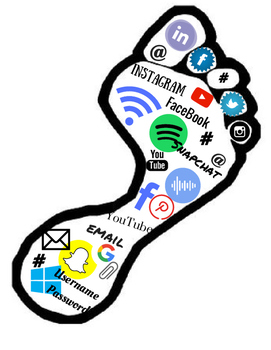What the Tech?
Make your “digital footprint” a part of your estate planning
 Every day, more than 10,000 people receive “Happy Birthday” greetings on Facebook.
Every day, more than 10,000 people receive “Happy Birthday” greetings on Facebook.
Many of those 10,000 people have passed away! However, their families can’t take down their Facebook pages. (www.goodlifeorganizing.net/digital-estateplan)
According to Judith Kolberg, a professional organizer and book author who specializes in helping families create digital estate plans, identity thieves sometimes target these Facebook pages.
“Every year, 15 million social media identities are stolen or hacked and of those, 2.5 million belong to dead people,” Kolberg says.
Your digital footprint will probably outlive you.
What is a digital footprint?
As defined by techterms.com, a digital footprint is a “trail of data while using the internet.” There are two kinds of digital footprints. A “passive” digital footprint is a data trail that one might leave online when visiting a website. The web server logs an IP address (the internet service provider) and location, and this search may be part of your computer’s search history. An “active” digital footprint includes information you submit online via email, Facebook status update, tweet, Instagram photo, blog post or personal data given during an online purchase. Generally the more time you spend online, the larger the digital footprint you create.
Create a digital estate plan
It is daunting to create a last will and testament, but it is imperative to do so. Think of a will as the last gift that you give your family: peace of mind. It will help your family distribute your beloved possessions and any monetary gifts. A digital estate plan works in much the same way as a last will and testament. It instructs your family about how to close your social media accounts, online banking accounts, Facebook page, website domain, photo accounts and more. (Facebook has instructions on how to change a page to a memorial page.) A digital estate plan is relatively easy to create; it is simply a listing of your social media accounts, usernames and passwords and a plan for what to do to close them.
What to include in your digital estate
Create an inventory of all your social media accounts, online banking, online photo albums, etc. Include:
- Name of the account (PayPal, Facebook, Twitter, online banking, etc.)
- Account number (if applicable)
- URL
- Username
- Password
- Security question(s) and answer(s)
- Detailed notes on what to do with the account (close the account? Or in the case of Facebook, memorialize the account for a while, then close it?, etc.)
Be sure to update the inventory a few times each year to keep it current, especially if you shop online or are active on several social media platforms.
Storing your digital estate plan
There are several options for creating and storing your digital estate plan:
- You can store it in a password-protected spreadsheet and give the password to a trusted family member or friend.
- You can store it on a thumb drive and give that to a trusted loved one. Think of this person as the digital executor of your estate. It is best to designate someone who is comfortable with technology.
- Use one of the apps that keep all your passwords and accounts in one online space, for your current use as well as when you pass. Apps such as LastPass, DashLane or KeePass are all good password keepers. Be sure to include the username and password in your will, or better yet, make your digital estate plan a part of your will.
Compiling your digital information may seem tedious, but your family will be happy to have it at their fingertips.
Check out your local FiftyForward center to learn more about computer tech classes!
By Misa Acox
Previously published in Forward Focus, March 2018.


